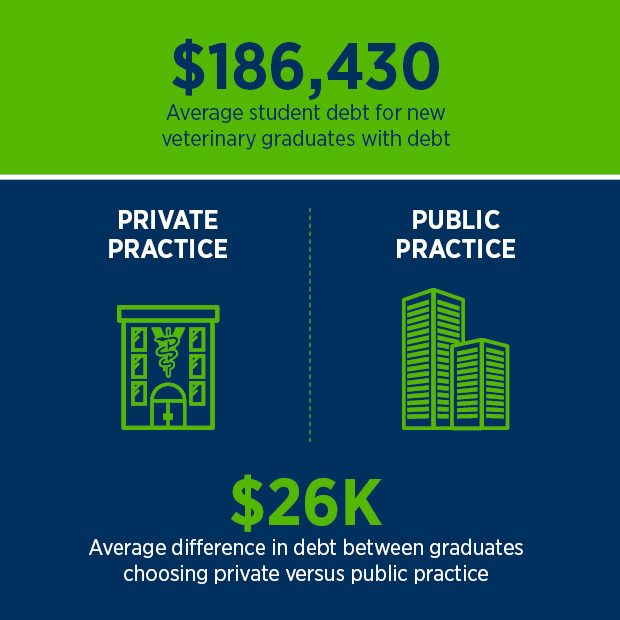Chart of the Month: Does student debt influence career choices?
Educational debt continues to increase. As of 2021, the average veterinary school graduate with debt owed $186,430 in student loans—up 17% from 2011, adjusting for inflation.
To help understand and manage this trend, AVMA economists have been conducting deeper dives into how student debt is impacting the profession. One key finding: student debt may be related to the career choices of graduating students.
What do the data show?
New graduates who choose to work in private practice have $25,675 more student debt, on average, than those headed into public practice positions.
While we don’t know the reasons behind each graduate’s career choice, we do know that public practice—including positions in government, uniformed services, academia, industry, commercial operations, and not-for-profit organizations—typically pays less than private practice. Starting salaries for graduates choosing private practice averaged $98,705 in 2021, versus $84,872 for public practice.
What does this mean?
The data, coming from two decades of AVMA’s annual surveys of graduating students (2001–2021), suggest that debt level is associated with career choices of new graduates. The higher a student’s debt, the more likely they will choose a job with a higher starting salary.
These findings could help to explain why it’s been hard to attract veterinarians into public practice, despite targeted incentives like the Public Service Loan Forgiveness program. Public practice remains an uncommon career choice, attracting only 3.7% of new graduates in 2021. This matters because veterinary involvement in these areas can translate to huge benefits for society as we strive to understand, detect, control, and prevent threats to public and animal health—roles for which veterinarians are uniquely qualified.
AVMA has your back: What we’re doing to help
Ideally, veterinarians at all career stages would be free to pursue their dreams, without any constraints posed by educational debt. This is one reason the AVMA puts high priority on developing programs and resources to relieve debt and help veterinarians thrive in rewarding and financially sustainable careers. Here’s a sample of AVMA’s work:
- In Washington, AVMA works closely with lawmakers to support programs that alleviate veterinary student debt—and to oppose policies that would worsen it. This includes working to protect and improve Public Service Loan Forgiveness, among many other advocacy efforts. This work has tangible results for AVMA members and other veterinary professionals. For example, the 2022 federal budget includes millions of dollars for important veterinary programs, including a funding increase for the Veterinary Medicine Loan Repayment Program.
- AVMA’s economists continue to delve into the impacts of educational debt on the profession and how debt might be reduced or even prevented. Most recently, they’ve published reports in JAVMA exploring associations between student debt and career choice, and differences between new graduates with and without student debt.
- The AVMA’s website for veterinary students and early-career veterinarians, My Veterinary Life®, offers videos and other financial resources to help new veterinarians get started on a path to firm financial footing. The site is tailored for current students, new veterinarians, and rising professionals.
- AVMA Axon® offers a variety of webinars on student debt and other financial issues. Topics include student loan repayment options and buying a practice even if you have debt, among others.
- AVMA and partners continue to drive the Veterinary Debt Initiative, with the mission of reducing the impact of the cost of education on the pursuit of a personally and professionally rewarding veterinary career.





Comments
Add New Comment